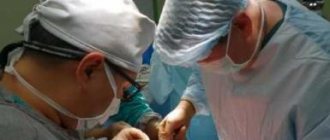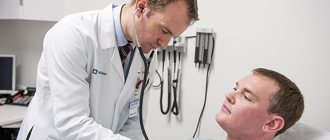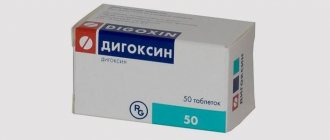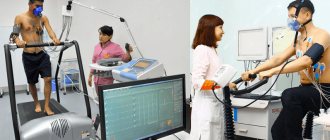Victoria Popova
Cardiologist
Higher education:
Cardiologist
Saratov State Medical University named after. IN AND. Razumovsky (SSMU, media) Level of education - Specialist 1990-1996
Additional education:
“Emergency Cardiology”
1990 - Ryazan Medical Institute named after Academician I.P. Pavlova
Contacts
Vagal arrhythmia is a difficult to diagnose heart rhythm disorder. In most cases, it is defined as atrial fibrillation. There is no clear clinical picture of this disease. According to research results, men are more likely to suffer from this form of the disease than women. The average age of patients with vagal-type cardiac arrhythmias is 45 years. This type of arrhythmia extremely rarely becomes chronic.
The mechanism of development of vagal type arrhythmia
Vagal arrhythmia is also called neurogenic. In 60% of cases, its development is preceded by bradycardia. Seizures occur in patients with disorders of the autonomic regulation of cardiac activity. The parasympathetic part of the nervous system works excessively, which causes an attack of arrhythmia. Heart rhythm disturbances most often occur at rest. One of the distinctive characteristics of this type of arrhythmia is that it does not appear during periods of physical or mental stress.
In its pure form, vagal-type heart rhythm disturbances are extremely rare. This variant of paroxysmal atrial fibrillation may predominate, but it will not be the only one. There is also a direct relationship between the condition of the internal organs and this disease. It does not arise by itself, i.e. the patient definitely has problems with the heart or thyroid gland.
Diagnosis of atrial fibrillation
Before determining what treatment atrial fibrillation requires, it will need to be diagnosed, for which the following are used:
- ECG;
- Holter monitoring – round-the-clock recording of ECG in a patient leading a normal rhythm of life;
- recording of paroxysms in real time (when the Holter monitor is capable of transmitting signals via telephone in the event of an attack).
Atrial fibrillation is reflected on the ECG as follows:
- There is no P wave in all leads.
- Irregular frequent f-waves of atrial fibrillation appear, which reflect their chaotic contractions and excitations. The amplitude of the coarse f-wave shape exceeds 1 mm and has a frequency of 350 to 450 waves per minute. This form of atrial fibrillation is characteristic of atrial hypertrophy; it occurs in patients with chronic cor pulmonale and mitral stenosis.
- The amplitude of the fine-fiber f-wave is so small that it is sometimes invisible on the ECG, and its frequency reaches 600-700. A similar form occurs in elderly people who have survived a heart attack, suffering from atherosclerotic cardiosclerosis, myocarditis, thyrotoxicosis, and with intoxication with cardiac glycosides.
- The arrhythmia of ventricular QRS complexes is expressed by different durations of RR intervals. The size and shape of the QRS complexes are usually normal.
Causes of the disease
There are several factors that provoke the development of vagal heart rhythm disturbances. The least common is a genetic predisposition to this type of arrhythmia. The disease manifests itself at an early age (20-30 years), which allows doctors to assume that the main factor was heredity, and not any congenital diseases. Other causes of arrhythmia include:
- binge eating;
- wearing tight clothing;
- bloating and flatulence;
- wearing tight accessories around the neck, waist and tight clothing;
- horizontal body position.
Doctors discovered a pattern between attacks and time of day. Most often, patients suffer from arrhythmia at night and early in the morning. A person can also provoke an attack himself, for example, if he constantly eats a lot. An overcrowded intestine creates excessive pressure on the internal organs, which leads to the development of vagal heart rhythm disturbances. The risk zone includes patients over 40 years of age. Significant excess weight also worsens the overall course of the disease. Drinking alcohol can trigger an attack.
Symptoms of vagal arrhythmia
This heart rhythm disturbance is classified as paroxysmal. The main problem is that the patient himself is often unaware that he has this type of arrhythmia. At the initial stages, changes in heart rate are quite minor, so it is very difficult to detect them. Rhythm disturbances of vagal origin are very difficult to identify. If the disease proceeds without any side complications, the patient will experience the following symptoms:
- heartbeat that speeds up and slows down without a specific rhythm;
- unmotivated attacks of fear that can turn into panic attacks;
- trembling in the upper and lower extremities;
- increased urine production, which leads to frequent urge to go to the toilet;
- severe dizziness (if the attack began after eating or drinking alcohol during the day);
- breathing problems even in a relatively calm state;
- it is impossible to take heart sounds and determine blood pressure;
- the skin is too pale, cyanosis may be observed;
- a small number of patients develop seizures;
- there is weakness and mental discomfort.
It is noteworthy that in many patients the symptoms of the disease disappear on their own without taking any medications. But do not forget that atrial fibrillation of vagal origin also requires drug treatment, so you should consult with your doctor to select drugs that will stop the attack. Sometimes the patient may notice pulsation of the venous vessels in the neck, breathing problems and slight heaviness in the chest, but will not experience any pain. This also indicates that he has vagal arrhythmia.
Contraindications to vagal tests
You cannot carry out tests to restore normal rhythm on your own if you have a rapid heartbeat, which is accompanied by the following symptoms:
- severe chest pain - shortness of breath, cough with foamy sputum - severe weakness, decreased blood pressure - loss of consciousness - pallor or bluish discoloration of the skin - convulsions, impaired sensitivity and movement in the limbs.
These symptoms may be signs of life-threatening rhythm disturbances and complications (heart attack, stroke, pulmonary edema), so any effect on cardiac activity is dangerous. You should call emergency medical help as quickly as possible.
The doctor should not conduct tests if the following diseases are suspected:
— pulmonary embolism — acute cerebrovascular accident — acute coronary syndrome — severe atherosclerosis of the aorta
Possible complications of the disease: thromboembolism and heart failure
Despite the fact that vagal-type heart rhythm disturbances are most often temporary, they may indicate serious disturbances in the functioning of the body. If a person has mitral valve stenosis, then during an attack the vessel may become blocked. The patient's heart will suddenly stop, which will lead to death.
Another scenario is that blood clots enter the arterial system of the systemic circulation. This can cause thromboembolism in various organs. According to statistics, 70% of cholesterol plaques enter the cerebral vessels. Such patients most often develop ischemic stroke.
Patients over 65 years of age are susceptible to thromboembolism. If a person has previously suffered a similar disease due to ailments that have long been present within the body (diabetes mellitus, heart failure, etc.), then the likelihood of a repeated rupture of a blood clot increases 4 times. Heart failure develops in patients suffering from heart defects and having problems with the contractility of the stomach.
One of the complications of insufficiency due to vagal arrhythmia is considered to be cardiogenic shock. The situation is worsened by the fact that the attack most often occurs at night. The patient's relatives simply cannot provide him with appropriate assistance, so cardiac arrest occurs. If left untreated, any type of atrial fibrillation leads to chronic heart failure.
Forms of atrial fibrillation
Forms of atrial fibrillation may differ in the characteristics of the clinical manifestation of the disease, etiological factors or electrophysiological mechanisms.
Persistent atrial fibrillation is divided into:
- Paroxysmal - lasts up to 1 week, divided into daily periods.
- Persistent.
- Chronic.
The last two types of atrial fibrillation last more than 1 week.
Such types of cardiac arrhythmias as persistent and paroxysmal can be recurrent. In this form, an attack can either appear for the first time or return as a relapse; in the latter case, a second and subsequent cases of fibrillation appear.
Classification of atrial fibrillation by type of rhythm disturbance:
- Atrial fibrillation, or atrial fibrillation, is caused by the contraction of disparate groups of muscle fibers, which prevents the atrium from contracting in a coordinated manner. Electrical impulses are volumetrically concentrated in the atrioventricular node, which is why some of them are delayed, and the rest are sent to the myocardium, causing the ventricles to contract in a certain rhythm.
- Atrial flutter. In this case, heart contractions increase to 200-400 per minute, while the atrial rhythm remains clear and coordinated. In this case, the following picture is observed: myocardial contractions follow one after another, almost without any pauses, and there is also no diastolic pause. At the same time, relaxation of the atria also does not occur, this is explained by the fact that they are in a systolic state most of the time. Since the atria are hardly filled with blood in this mode, it enters the ventricles in noticeably smaller quantities. With this form of atrial fibrillation, impulses propagating along the atrioventricular connections reach the ventricles only in every second, third and fourth case, due to which the correct ventricular rhythm is maintained, which is characterized by the term “correct flutter”. If for one reason or another there is a blockade and conduction is impaired, then the ventricles begin to contract chaotically. The result of this is that atrial flutter takes on a distorted form, which is called “irregular flutter.”
Classification of arrhythmia by contraction frequency:
- Bradysystolic arrhythmia is when the ventricles beat no more than 60 times per minute. During paroxysm, blood is not pumped into the ventricles, since the atria do not work efficiently, and the diastoles of the ventricles are filled naturally and only partially. As a result, the ejection of blood into the aortic system practically stops.
- Tachysystolic arrhythmia - contractions occur with a frequency of 90 beats.
- Normosystolic arrhythmia - ventricular contractions can be kept within 60-90 beats.
Manifestations of heart rhythm disturbances are divided into:
Paroxysmal;
This form of arrhythmia is characterized by a series of paroxysmal symptoms and regular rhythm. The frequency of fibrillations varies. Sometimes patients experience only one attack in their entire life. And in other people they are repeated several times a day. After this, the person’s condition returns to normal.
Paroxysmal arrhythmia can be stopped independently or with the use of medications. The attack is manifested by a sharp change in heart contractions, which become fast and arrhythmic. As a result, the heart does not receive enough blood and, accordingly, other organs too.
The patient's body begins to adapt to the new work of the heart muscle and normalizes its health during the period of atrial fibrillation. A person feels worst when transitioning from arrhythmia to regular sinus rhythm and in the opposite direction.
Constant;
This form of heart contraction disorder develops gradually. It includes attacks of atrial fibrillation that last for several weeks or longer. It occurs as a primary pathology or after a long-term paroxysmal form of fibrillation.
The patient's health depends on how often the heart beats. If this indicator is close to normal, but slightly increased, then the person will practically not feel any disturbances or unpleasant effects. But with a significant increase or decrease in heart rate, health will deteriorate.
The two forms of atrial fibrillation present differently, but the prognosis of the disease depends on their severity. In any case, in order to restore the normal heart rate, it is necessary to undergo an examination and find out the cause of the pathology.
Features of diagnosing vagal arrhythmia
The disease can only be detected through daily monitoring. If attacks are rare, which is typical for the vagal course of the disease, event monitoring is used. In the latter case, the patient constantly carries with him a specialized device that interacts with a smartphone. If an attack begins, it transmits a signal to the phone, and it begins recording. Also, patients suspected of this form of arrhythmia should undergo the following examinations:
- electrocardiogram;
- echocardiography;
- blood test for hormone levels.
All these procedures will help identify abnormalities in the functioning and structure of the heart. Assessing hormone levels will help determine how well your thyroid gland is working.
How is this disease treated?
Treatment for vagal arrhythmia aims to normalize the heart rhythm and prevent further atrial fibrillation. It can be medicinal and surgical. The heart rate is monitored and measures are taken to prevent thromboembolism. Patients with vagal rhythm disorders are advised to avoid:
- eating too much food;
- sleep on a full stomach;
- physical inactivity.
It is necessary to normalize nutrition. If the patient eats a lot of fatty or salty foods, he will not only strain the intestines, but also create unnecessary pressure on the heart. Another disadvantage of an unbalanced diet is constipation and other gastrointestinal problems. They also increase the frequency of seizures.
The patient must normalize weight. To do this, gradually reduce the calorie content of food. Preference should be given to foods containing a lot of fiber. You need to eat at least 4 hours before bedtime. If the patient is very hungry, he can drink kefir an hour before bedtime.
Drug therapy
The main purpose of taking medications is to normalize the heart rate. Normalization of the pulse is necessary in order to reduce the likelihood of stroke and cardiogenic shock. Several groups of drugs have been developed specifically for these purposes. But they should be prescribed exclusively by a doctor. You cannot choose your own medications against arrhythmia.
Beta blockers and calcium blockers
Most often, patients are given beta blockers for arrhythmia. They are considered the most universal way to treat such a disease. Metoprolol belongs to this group of drugs. But it is still more effective to take them if a person has increased activity of the sympathetic nervous system. Calcium blockers are used if the patient does not have cardiac symptoms and is intolerant to beta blockers. Drugs in this group are contraindicated for people with cardiac asthma.
Sodium channel blockers
Medicines in this group reduce the rapid depolarization of cardiac fibers. They stabilize cell membranes and relieve signs of arrhythmia. Long-term treatment of vagal-type heart rhythm abnormalities is possible only with these drugs. While taking medications of this group, patients may experience the following symptoms:
- slowing of impulse conduction through the atria;
- slight increase in sinus rhythm;
- decrease in the rate of ventricular repolarization.
These medications can only be taken as prescribed by a doctor when the patient is diagnosed with a predominance of vagal type symptoms. For other types of arrhythmias, these medications can be harmful. Sodium channel blockers include Allapinin, Novocainamide, Propanorm.
Allapinin
A drug developed specifically for the treatment of paroxysmal arrhythmias. It is taken only after a doctor's prescription. After taking the tablets, the patient should refrain from driving. Patients who have been diagnosed with electrolyte metabolism disorders and blockade of one of the His bundle branches should drink it with caution. You cannot combine the medicine with other antiarrhythmic drugs. If allergic reactions occur, Allapinin should be discontinued.
Novocainamide
This drug belongs to the category of membrane stabilizing drugs. It reduces the speed of impulses passing through the atria and ventricles. In case of chronic renal and heart failure, you cannot take the medicine for a long time, because it accumulates in the body, which can cause toxic poisoning. The drug is administered intravenously.
Propanorm
The drug is taken when it is necessary to quickly block sodium channels. The product has a local anesthetic effect. The rate at which depolarization decreases depends on the dosage of the drug. The maximum concentration of the drug in the blood occurs 1 hour after administration. If the sinus node is weak, it is not prescribed.
Surgery
If a patient experiences a pathological slowdown in heart contractions, he is referred for surgery. With radiofrequency ablation, the connection between the ventricle and the atrium is partially disrupted, so the arrhythmia no longer constantly torments the patient. In more advanced cases, patients are implanted with a cardioverter-defibrillator.
Method of conducting vagal tests
Vagal techniques are performed at home on your own or in the hospital. Carotid sinus massage, especially in older people, is best done under the supervision of a physician. The patient is placed on the couch on his back, his head is turned to the left and the right side of the neck is massaged at the angle of the lower jaw. At the same time, an ECG is recorded and blood pressure is measured. Pressing on the sinus in a circular motion is carried out for 5 - 10 minutes, after which, if necessary, the doctor can begin massage on the left. It is unacceptable to massage both sinuses at the same time, as this can lead to depletion of blood flow in the brain.
Other tests can be performed at home if the doctor has already taught the patient these techniques. For skin reflexes, it is enough to wash your face with cold water, wipe your face with an ice cube, or immerse your face in a basin of ice water for a few seconds, after holding your breath.
It is not necessary to actually induce vomiting; it is enough to press the root of the tongue with a spoon several times intermittently, by analogy with a doctor examining the tonsils and pharynx. You can imitate a cough or strain as if you were having a bowel movement.
Is it possible to be completely cured?
If you follow your doctor's recommendations, the risk of complications becomes minimal. The patient must learn to provide first aid to himself when he begins an attack of vagal arrhythmia. If the patient has been prescribed a course of medications, he must drink them completely. If you experience any side effects from your medications, you should tell your cardiologist. The patient can recover completely if he radically changes his lifestyle. You should not only take pills, but also change your diet and do exercise therapy.
Folk remedies for vagal arrhythmia
Some patients find folk recipes quite helpful in normalizing their heart rate. But you should always consult with your doctor first so as not to encounter unexpected negative effects of such drugs. Herbal infusions should absolutely not be taken by allergy sufferers, because... they can cause a reaction. To treat arrhythmia, infusions of the following herbs are used:
- calendula;
- viburnum;
- rosehip;
- hawthorn;
- motherwort.
They are all prepared according to approximately the same recipe. 20-30 grams of dry plant should be diluted with 250-300 ml of hot water. The mixture should be allowed to brew for 40 minutes, then strain and take 2-3 times a day. Remember that folk recipes cannot completely replace medications. They play the role of additional, rather than primary therapy.











